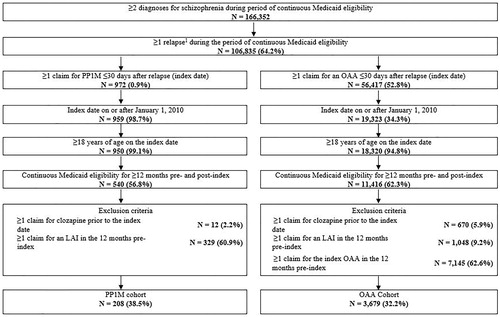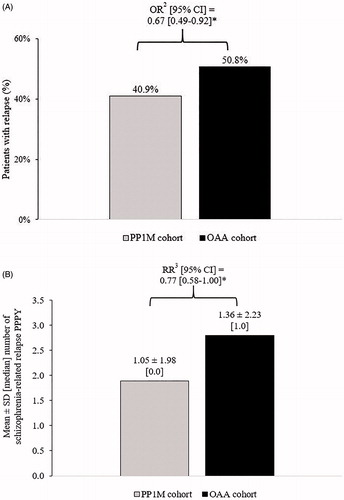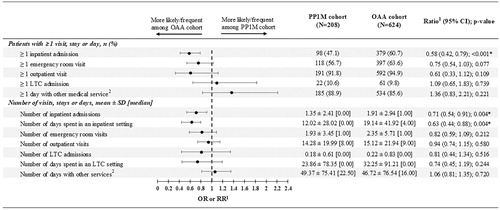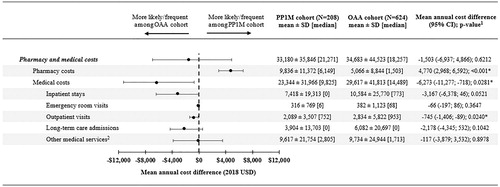Figures & data
Figure 1. Identification of the study population. Abbreviations: LAI, long-acting injectable; OAA, oral atypical antipsychotic; PP1M, once-monthly paliperidone palmitate Note:1Relapse was defined as an inpatient admission or emergency room visit with a diagnosis code for schizophrenia.

Table 1. Baseline demographic and clinical characteristics in the overall and matched PP1M and OAA cohortsa.
Table 2. Healthcare resource utilization and healthcare costs PPPY during the 12-month baseline period.
Figure 2. Comparison of (A) the proportion of patients with subsequent schizophrenia-related relapses1 and (B) the number of subsequent schizophrenia-related relapses PPPY in the PP1M and OAA cohorts during the 12-month follow-up period. Abbreviations. CI, confidence interval; OAA, oral atypical antipsychotics; OR, odds ratio; RR, rate ratio; PPPY, per patient per year; PP1M, once-monthly paliperidone palmitate; SD, standard deviation. Notes. *Significant at the 5% level. 1Relapse was defined as an inpatient admission or emergency room visit with a diagnosis for schizophrenia. 2ORs (binary variables) including CIs and p-values were estimated using logistic regression models. 3RRs (count variables) were estimated using Poisson regression models. CIs and p-values for RRs were estimated from a non-parametric bootstrap procedure (N = 499).

Figure 3. Comparison of all-cause healthcare resource utilization PPPY between PP1M and OAA cohorts. Abbreviations. CI, confidence interval; LTC, long-term care; OAA, oral atypical antipsychotic; OR, odds ratio; PPPY, per patient per year; PP1M, once-monthly paliperidone palmitate; RR, rate ratio; SD, standard deviation. Notes. *significant at the 5% level. 1Odds ratios (binary variables) including CIs and p-values were estimated using logistic regression models. Rate ratios (count variables) were estimated using Poisson regression models. CIs and p-values for rate ratios were estimated from a non-parametric bootstrap procedure (N = 499). 2Other services included mental-health institute admissions, one-day mental-health institute outpatient visits, home care, and other services.

Figure 4. Comparison of all-cause healthcare costs PPPY between PP1M and OAA cohorts. Abbreviations. CI, confidence interval; LTC, long-term care; MCD, mean cost difference; OAA, oral atypical antipsychotic; PPPY, per patient per year; PP1M, once-monthly paliperidone palmitate; SD, standard deviation; US, United States. Notes. *significant at the 5% level. 1Estimated using an ordinary least squares regression model. CIs and p-values were estimated from a non-parametric bootstrap procedure (N = 499). 2Other services included mental-health institute admissions, one-day mental-health institute outpatient visits, home care, and other services.

